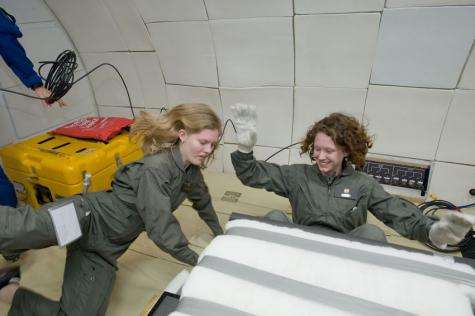Harvesting energy

Imagine a cell phone battery that charges with every step you take or a spacesuit that uses astronauts' expended energy to run the suit's electronics. A team of college students conducting NASA research on this innovative use of nanotechnology took their research to new heights. The team, comprising Hannah Clevenson, Olivia Lenz and Tanya Miracle, flew an experiment related to their nanotechnology research on a NASA reduced-gravity flight.
The Reduced Gravity Student Flight Opportunities Program at NASA's Johnson Space Center in Houston offers teams of undergraduate students the opportunity to propose, design, fabricate and fly experiments on a special reduced-gravity aircraft. The airplane makes a series of steep climbs followed by steep dives, called parabolic arcs, resulting in short periods of reduced gravity.
The team's experiment investigated the properties of zinc oxide nanowires produced in microgravity conditions and compared the results with the properties of zinc oxide nanowires produced in the laboratory. In particular, the team was interested in the effects of reduced-gravity on the morphology of the samples.
The students were participating in NASA's Motivating Undergraduates in Science and Technology, or MUST, project. NASA engineer Tamra George mentored the team.
According to Hannah Clevenson and the team's abstract, it is feasible that longer and straighter nanowires, as well as a larger quantity, could be produced in microgravity. These new and improved nanowires then could be used for a variety of applications, one of those being improved batteries.
Clevenson, an electrical engineering student at Cooper Union in New York City, said that while zinc oxide nanowires have been grown in many ways in the laboratory, little research has been done in the area of nanowire growth in microgravity.
"Nanowires have the potential to be used in a wide range of applications, from electronic devices to high capacity batteries," states the team's abstract. "ZnO (zinc oxide) is very inexpensive and has piezoelectric properties, and thus a highly desirable material. When a piezoelectric material is stressed, a voltage difference is created across the material. These types of materials could be used to harvest energy that is expended during routine daily tasks and possibly be useful as very compact, low-power backup energy sources for both robots and astronauts on lunar or planetary missions."
Team member Olivia Lenz said people are "wasting" energy to the environment all the time just by walking or moving their arms. "You can't stop this energy from escaping, but there may be a way to capture it, 'scavenge' it, and then charge a small battery," she said.
"Basically, the material we developed is piezoelectric, which means that when you bend or strain it, you distort the crystal structure and cause a dipole to develop across the length of the material. Eventually, this dipole change can be harnessed and produce an electric current that can be used to charge a device like your iPod or cell phone by walking. This topic is important because it can allow members of the military out in the middle of nowhere to charge their electronics without needing the sun or a generator. Or, the same material could be integrated into spacesuits to help sustain the electronics astronauts carry on their person when on an EVA."
University of Akron chemical engineering student Tanya Miracle added that a second benefit of the team's zinc oxide nanowire research is the potential for improving consumer batteries. "Zinc oxide holds up to 10 times the charge of lithium, so potentially it could replace lithium used in batteries," Miracle said. "This could either produce smaller batteries that allow for the same amount of energy to be stored or a battery that is of the same size, but could last 10 times as long. The electric car industry could easily use this to their advantage."
One of the challenges the team faced was that the team’s MUST assignments had them working at different NASA centers. Lenz and Clevenson were both at NASA's Ames Research Center in Moffett Field, Calif., while Miracle was at NASA's Glenn Research Center in Cleveland, Ohio. The girls had to find ways to work together as a team despite their geographic differences. "In school, we have a project management and teamwork class we are required to take, but managing a project with team members hundreds of miles away is very different," Miracle said. "I think that this really helped me to learn to be a better project manager as well as a better researcher in general. I now know how to share knowledge across many miles in a productive and effective manner."
Another real-life lesson learned from the experience, Lenz said, is how engineers function in the real world, with hard deadlines and troublesome experimental equipment.
"I was not prepared for how exhausting the process would be when in Houston, nor was I prepared for the number of issues that we ran into," said Lenz, who is majoring in chemistry at Seattle Pacific University. "Basically, if it could go wrong, it did go wrong! Every day I went home exhausted and not sure if we were going to make it on the plane. Even after our first flight day we had to unload the experiment and troubleshoot! Apparently, this is what real engineers do everyday."
Funded and managed by NASA, Motivating Undergraduates in Science and Technology is administered by the Hispanic College Fund. The project awards scholarships and internships to undergraduates pursuing degrees in science, technology, engineering and mathematics, or STEM, fields. It supports NASA's goal of strengthening the agency's and the nation's future workforce.
Provided by JPL/NASA
















